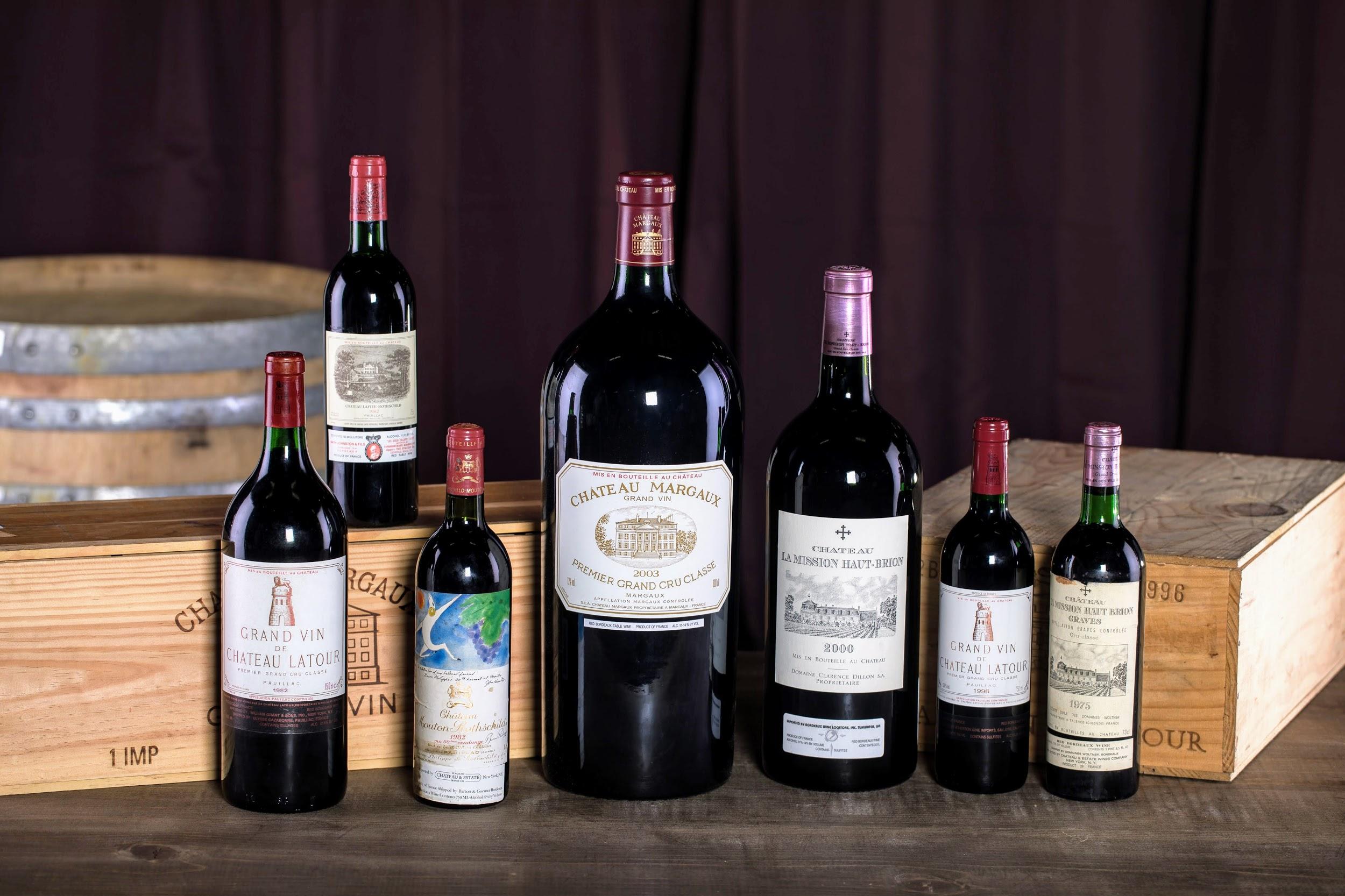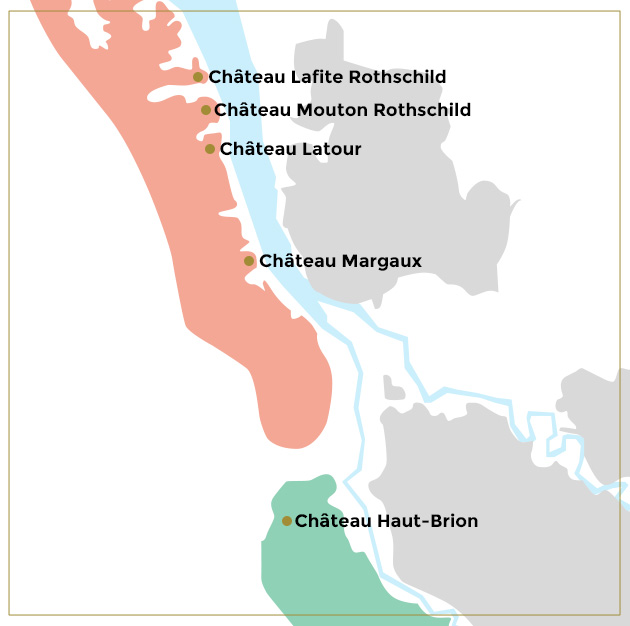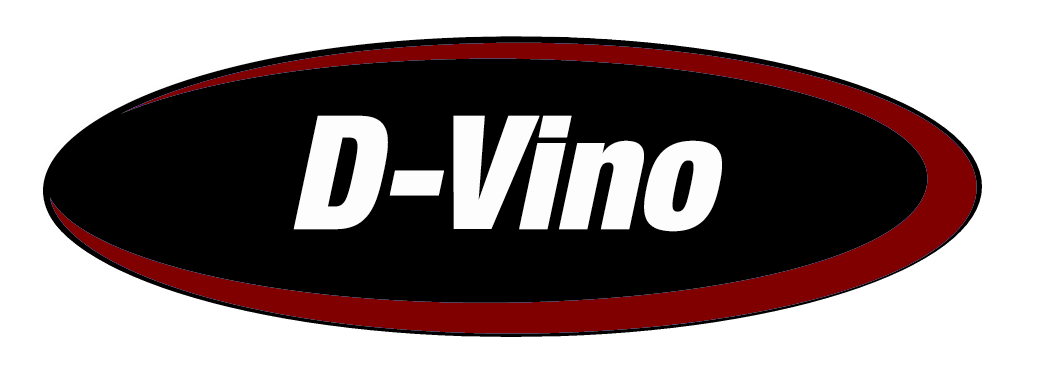
First-growth Bordeaux wine is among the most valuable and collectible wine in the world.
To say first-growth Bordeaux wine is high in quality is an understatement. There are only five first-growth estates in Bordeaux, and each of them crafts some of the most elegant, prestigious, and valuable wines in the world. Wines with official first-growth classifications are often worth hundreds, if not thousands, of dollars more than their lesser-ranked peers and are considered by many to be the cornerstone of any serious French wine collection.Â
However, while all of these wines are highly rated and valuable, they donât all taste the same. Château Margaux, Château Latour, Château Lafite Rothschild, Château Haut-Brion, and Château Mouton Rothschild each have a distinctive winemaking style, unique terroir, and blending techniques that give their wines a specific character. As you build a collection of first-growth Bordeaux wine, you will likely find that you prefer some first-growth wines over others. To help you decide which wines to add to your own collection, weâve created this detailed guide to Bordeaux first-growth labels. Weâll explain what makes each of these labels unique and worthy of such high praise from the worldâs leading wine critics.Â
What Is First-Growth Bordeaux Wine?Â
First-growth Bordeaux wine is an official classification that ranks the most notable and high-quality producers in the region. There are only five producers that currently hold first-growth classification status:Â
- Château Haut-Brion
- Château Lafite Rothschild
- Château Latour
- Château Margaux
- Château Mouton RothschildÂ
First-growth became an official classification in 1855 during the Exposition Universelle de Paris. At the time, French leader Napoléon III wanted to establish the country as a leader in fine wine production, so he enlisted the help of the Gironde Chamber of Commerce to gather together a group of professional wine brokers. These brokers ranked French wine estates according to trading price, reputation, and overall quality, and first-growth was the highest-ranked classification. Today, these five first-growth estates still produce the most expensive wines in Bordeaux, on average, so the classification system is a simple and relatively reliable way for collectors to gauge which wines are the most valuable. But why have these estates in particular earned such a sterling reputation on the market? To understand their allure, you must consider the terroir and the estatesâ winemaking styles.Â
Many wine enthusiasts taste strong minerality in first-growth wines from the Médoc region.
Most first-growth Bordeaux wine is made in the Médoc subregion in southwestern Franceâs famed Left Bank. The only exception is Château Haut-Brion, which is from Graves in the Pessac-Léognan region.Â
 In Médoc, fast-draining gravel soils urge the vine roots to burrow deep underground in search of water. This ensures that the grapes never become too diluted and instead grow quite small and concentrated in flavor. The gravel also retains heat in the summer, which helps the grapes ripen fully. Many wine enthusiasts taste strong minerality in first-growth wines from this region and some experts believe this is due to the gravelly soil. In Graves, the soil is also very gravelly, which has a similar effect on grape ripening.Â
In Médoc, fast-draining gravel soils urge the vine roots to burrow deep underground in search of water. This ensures that the grapes never become too diluted and instead grow quite small and concentrated in flavor. The gravel also retains heat in the summer, which helps the grapes ripen fully. Many wine enthusiasts taste strong minerality in first-growth wines from this region and some experts believe this is due to the gravelly soil. In Graves, the soil is also very gravelly, which has a similar effect on grape ripening.Â
However, while vineyard location and soil do have a meaningful impact on the quality of the wine, the producersâ individual winemaking styles have an arguably greater effect. For example, even though Château Lafite Rothschild and Château Mouton Rothschild are located quite close to one another, the flavor of their wines is completely different. A flagship bottle of 2018 Château Lafite Rothschild is quite floral and spicy, while a bottle of 2018 Château Mouton Rothschild has stronger cocoa notes as well as flavors of cigar and camphor. This is in part because these two producers have very different winemaking philosophies and use different blending and aging techniques. To understand these differences between first-growth Bordeaux wine producers, it helps to assess each first-growth Bordeaux wine label individually.Â
The Most Valuable First-Growth Bordeaux LabelsÂ
The most expensive first-growth Bordeaux wine labels are the estatesâ flagship wines (called the grand vin). These are typically the most delicious and age-worthy first-growth bottles. Many second and third wines are also high in quality and worth collecting, but the grand vin bottles from these estates are still the most sought-after among collectors. In the chart below, youâll see what makes each of the first-growth grand vins stand out from their peers. The specific blends used vary with every vintage, so itâs also important to research each year individually before you invest.Â
Grand Vin Wines
| Wine | Blend | Tasting Notes | Average Price Per Bottle | Aging Potential | Winemaking Techniques |
| Château Haut-Brion Grand Vin | 50 percent Merlot, 40 percent Cabernet Sauvignon, ten percent Cabernet, and sometimes a small amount of Petit Verdot | Elegant and refined, with notes of earth, tar, spice, and truffle | $615 | 12 to 50 years or more (these wines generally drink younger than the other flagship first-growths) | The estate ferments the wine in stainless steel then ages it in new French oak for a maximum of 24 months |
| Château Lafite Rothschild Grand Vin | Between 80 and 95 percent Cabernet Sauvignon, between five and 20 percent Merlot, and up to three percent Cabernet Franc and Petit Verdot | Very tannic in its youth, with notes of plum, tobacco, hazelnut, and a unique salinity | $920 | 15 to 60 years or more | The estate uses a blend of grapes with different ripeness levels to craft wines that have a perfect balance between sweet, ripe flavors and fresh, tart flavors |
| Château Latour Grand Vin | 75 percent Cabernet Sauvignon, 20 percent Merlot, two percent Cabernet Franc, and small amounts of Petit Verdot | Very consistent in quality from year to year, with rich, powerful fruit flavors and strong minerality | $830 | 15 to 60 years or more | The estate uses primarily biodynamic winemaking to preserve the wineâs natural flavors |
| Château Margaux Grand Vin | 75 percent Cabernet Sauvignon, 20 percent Merlot, three percent Petit Verdot, and two percent Cabernet Franc | Harmonious and silky, with notes of violet, truffle, and dark fruit | $715 | 15 to 60 years or more | The estate has very old vines that produce complex-tasting grapes (some vines are nearly 80 years old) |
| Château Mouton Rothschild Grand Vin | 80 percent Cabernet Sauvignon, 16 percent Merlot, three percent Cabernet Franc, and one percent Petit Verdot | Perfumed and smoky, with notes of tobacco, black currant, pencil lead, and salt | $650 | 15 to 60 years or more | The estate hires teams of people to manage the same vines and parcels every year. This ensures that the wine is consistent in quality and that the vines remain very healthy |
Many collectors buy grand vin bottles from all five of the first-growth Bordeaux estates, while others choose to focus their collections on just one producer or style. For example, the earthiest first-growth wines are from Château Haut-Brion and Château Margaux. If youâre looking for wines with stronger minerality or salinity, then grand vin bottles from Château Mouton Rothschild, Château Latour, and Château Lafite Rothschild are excellent options.Â
Château Haut-Brion is the least expensive of the first-growths.
There are also differences in aging potential and value among the first-growths. Château Lafite Rothschild and Château Latour make the most expensive wines and these bottles also gain significantly in value over time. If youâre looking to resell your collection for a profit later, then these are two of the best choices. Grand vin from Château Mouton Rothschild is slightly less expensive than some of the other wines on this list, making these wines a good value. Château Haut-Brion is the least expensive of the first-growths, in part because these wines donât age quite as long as the others on this list. If youâre looking for a wine that will drink beautifully within the next 12 to 20 years, Château Haut-Brion is a good choice.Â
All of the wines in the list above are highly sought-after among collectors and exceptionally age-worthy, so itâs virtually impossible to make a bad investment. Still, some vintages are worth more than others, so before you make your decision on which wines to add to your collection, consult our guide to the best Bordeaux vintages in history.Â
Second and Third Wine Labels from First-Growth EstatesÂ
These five first-growth Bordeaux wine producers also make second and third wines that are spectacular. While these labels are not worth as much as their grand vin siblings, they are perfect for short-term aging and may also gain in value on the secondary market once they reach peak maturity. For example, Liv-ex reports that the price gap between the grand vin and second wine label is closing every year as the quality of second wines rises and collectors realize just how delicious these labels can be. While these wines will likely never be as valuable as the grand vins because they are still lower in quality overall and have less aging potential, these recent market statistics are a good sign that second wines can make solid investments.Â
Third wines made by first-growth estates are still excellent wines.
To determine which second wines are right for your collection, take a look at the detailed chart below. Keep in mind that the varieties in the blend vary from year to year.
Second Wines
| Wine | Blend | Tasting Notes | Average Price Per Bottle | Aging Potential |
| Château Haut-Brion Le Clarence de Haut Brion (formerly Château Bahans Haut-Brion) | 50 percent Merlot, 30 percent Cabernet Sauvignon, 15 percent Cabernet Franc, and two to five percent Petit Verdot | Smoky, with notes of cigar box, tobacco, and rich red berries | $140 | Five to ten years or more |
| Château Lafite Rothschild Carruades de Lafite | 55 percent Cabernet Sauvignon, 40 percent Merlot, and five percent Cabernet Franc | Medium-bodied and fresh, with notes of spice, red fruit, and black currant | $330 | Five to ten years or more |
| Château Latour Les Forts de Latour | 70 percent Cabernet Sauvignon and 30 percent Merlot, with some Petit Verdot | Layered and intense, with notes of black currant, cocoa, and tobacco | $250 | Five to ten years or more |
| Château Margaux Pavillon Rouge du Château Margaux | 75 percent Cabernet Sauvignon, 20 percent Merlot, three percent Petit Verdot, and two percent Cabernet Franc | Medium-bodied and silky, with notes of red berries, flowers, and tobacco | $220 | Ten years or more |
| Château Mouton Rothschild Le Petit Mouton de Mouton Rothschild | 55 percent Cabernet Sauvignon, 40 percent Merlot, and five percent Cabernet Franc | Perfumed, with notes of blackberry, tobacco, and licorice | $260 | Five to ten years or more |
Some estates also produce a third wine, which is generally even less valuable and age-worthy than an estateâs second wine. However, like a second wine, third wines made by first-growth estates are still excellent wines. A third wine from a first-growth producer can be higher in quality than a flagship wine or second wine from a fifth-growth producer.Â
The chart below details some of the primary differences between the third wines made by Château Latour and Château Margaux.
Third Wines
| Wine | Blend | Tasting Notes | Average Price Per Bottle | Aging Potential |
| Le Pauillac de Château Latour | 70 percent Cabernet Sauvignon and 30 percent Merlot, with some Petit Verdot | Soft and polished, with notes of spice, tobacco, earth, and cassis | $90 | Five years or more |
| Margaux du Château Margaux | 75 percent Cabernet Sauvignon, 20 percent Merlot, three percent Petit Verdot, and two percent Cabernet Franc | Fragrant and fresh, with notes of red fruit and tobacco | $100 | Five years or more |
Because these third wines drink even earlier than second labels, theyâre ideal for special dinner parties. These are also excellent wines to give away as gifts, particularly if the gift recipient loves first-growth Bordeaux wines and has never tried some of the other offerings from these estates. Youâre unlikely to make much of a profit from reselling these bottles, but if that isnât a primary goal of your collection, then these labels make an excellent addition to a collection of top-quality Bordeaux.
How to Collect the Finest First-Growth Bordeaux Wine
Whether youâre just getting started as a wine collector or you have been buying fine wine for many decades, you canât go wrong with first-growth Bordeaux wine. Wines from these estates are among the most reliable investments on the fine wine market, which means that beginner collectors can easily start a valuable collection from scratch. Any of the grand vin bottles from these estates will grow steadily in value over time, even if you purchase wine from lower-quality vintages. Because these producers have the resources and experience necessary to craft exceptional wine in difficult years, vintage quality is also very consistent. Itâs not necessary to wait for rare 100-point vintages to hit the market or spend hundreds or thousands of dollars more for a top-rated year. In fact, it may be wiser to invest in some of the less sought-after vintages because these wines often have a much higher overall quality-to-price ratio and are easier to find on the market.Â
Buying first-growth Bordeaux wine is often a lifelong investment.
The main tip to remember when collecting first-growth Bordeaux wine is that you should protect your investments with professional storage or another reliable storage method. This is true whether you plan on drinking the wine yourself or reselling it on the market later. Professional storage helps you prove the bottleâs provenance, so that you receive the highest possible price at resale. It also ensures that your bottles age gracefully over the decades so that they taste as complex and delicious as possible once they finally reach maturity. Buying first-growth Bordeaux wine is often a lifelong investment; you can even pass some of these bottles down to future generations. This is why itâs important to buy wine from trustworthy vendors, keep your bottles stored safely, and patiently wait to open them until they mature fully. These steps are crucial to building an impressive first-growth Bordeaux wine collection that you can enjoy for the rest of your life.Â
Whether you are starting your high-end wine collection or adding to an established portfolio, Vinfolio is your partner in buying, selling, and professional storage. Contact us today to get access to the worldâs finest wine.
The post First-Growth Bordeaux Wine: A Guide to the Best Labels appeared first on Vinfolio Blog.


